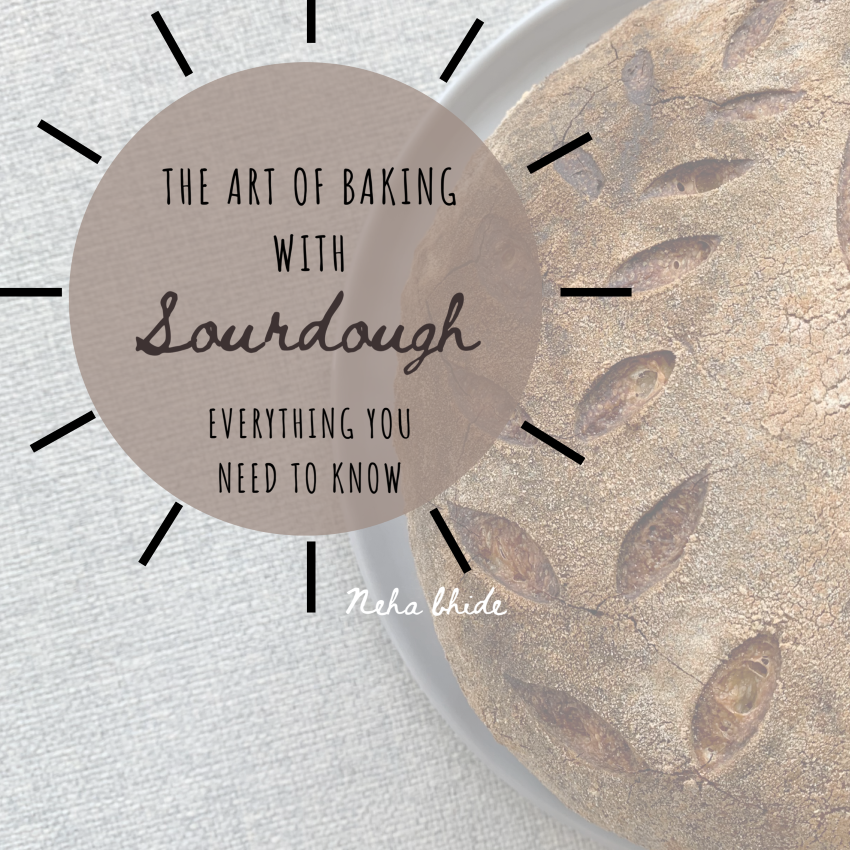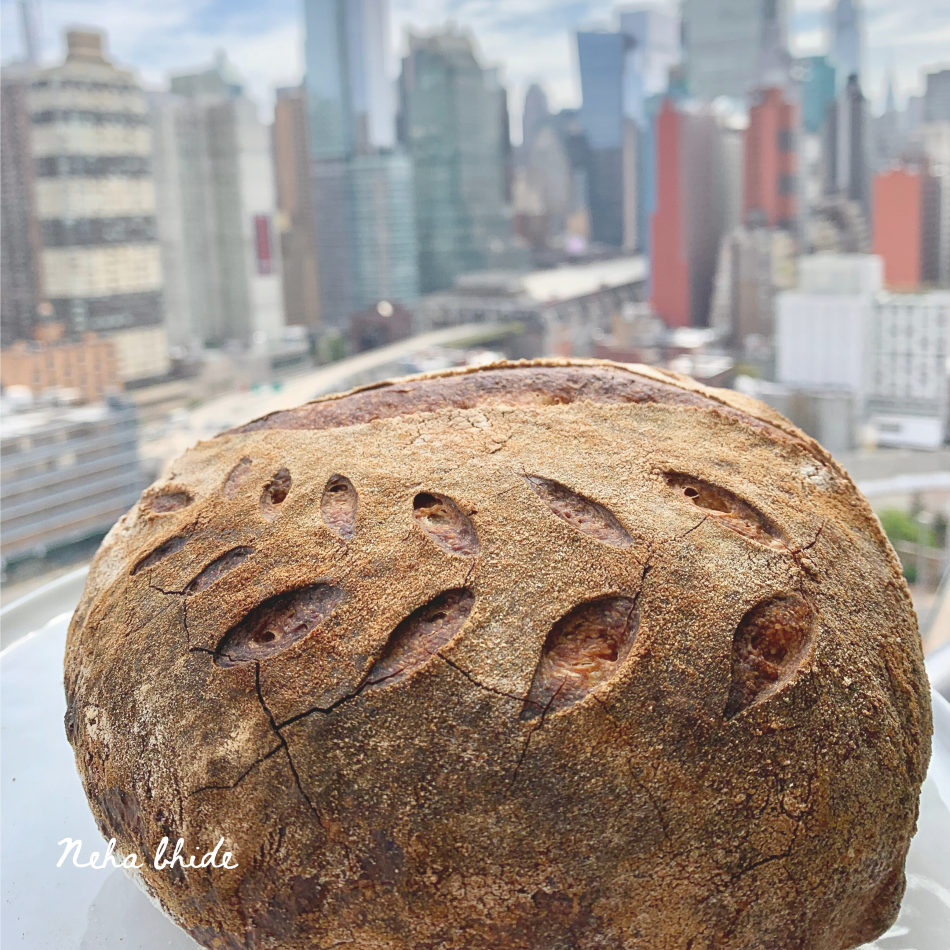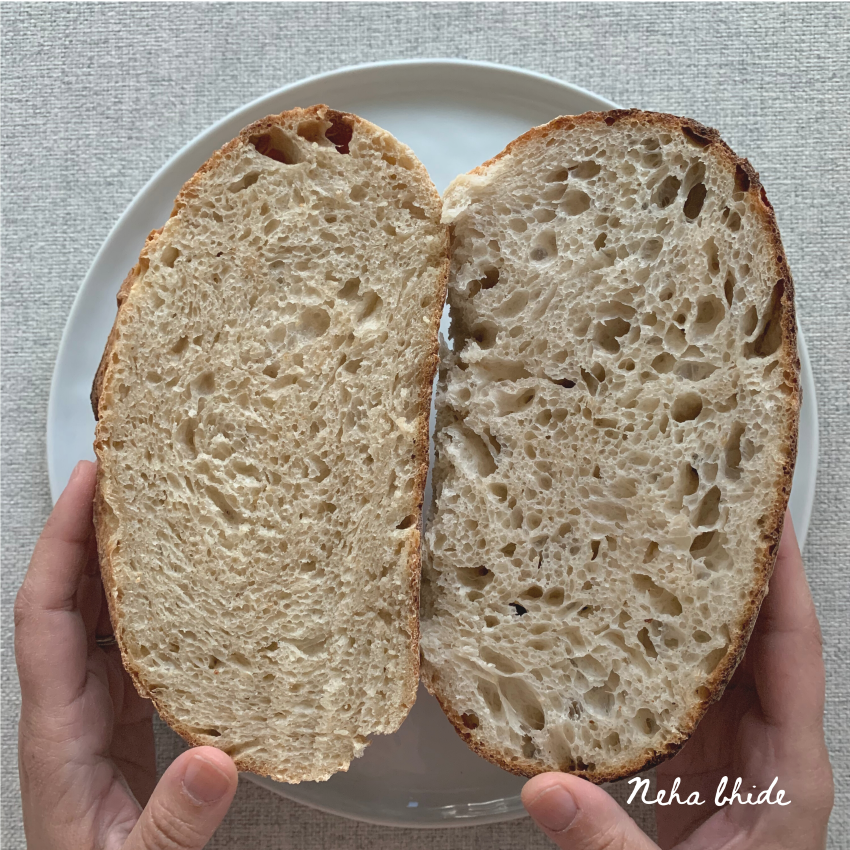The Art of Sourdough baking

The Art and Science actually!
Being a Food Scientist and a product developer, I see closely the constant struggle in the Food Industry to create foods that have a “clean label” – simple, fewer, familiar ingredients. No chemicals or ‘guilty ingredients’ (sugars, hydrogenated oils, flavors, dyes, etc.). Imagine if there were a really scrumptious bread – that had only 3 clean ingredients – flour, water and salt?! Good News – It exists and you can make it a week from now! And just look how gorgeous it looks:

Couple things first –
- Breads made using a sourdough starter aren’t always sour – YOU can decide if you want to make it tangy and use the starter at a particular point in its growth curve accordingly. I will tell you more about how exactly you can do this later – keep on reading 😊
- That plump crusty loaf, is one of the best things you can make with the starter, but its not the only thing you can make with it! Basically think of it as a natural, home-grown yeast substitute – remember, it doesn’t always make everything sour?! The name is just misleading.
Sourdough starter has quickly made an entry into my Kitchen staples and I now own a healthy, super-flavorful and powerful starter that is a few months old and has already helped me bake several loaves of Breads. It keeps giving and the best part is, if you care well for it, you can keep it for years and it will just keep getting better.
If I have not sold it enough already, it’s the simplest thing to make- minimal ingredients, minimal efforts and no room for error. The whole process – making the starter and seeing just two ingredients (3 if you count salt) become a miraculous loaf of bread that has a variety of textures and flavors and colors! It’s simply AWESOME – in the real sense of the word 🙂 So don’t be intimidated. It just takes some patience, consistency and practice and before you know it, you will be wanting to bake a loaf every weekend.
Starting your own sourdough starter:
So now that you are ready to dive into this magical experience of making your own sourdough starter and baking with it, you will first need to start growing your starter. Follow my recipe for the sourdough starter. You can find it here.
Maintaining your starter:
If you bake regularly (everyday or every other day), you can store the starter at room temperature on your kitchen countertop in a warm spot. If you bake with it once a week or so (Like I do), you can store it in the Fridge.
Once you are ready to bake with your starter, you will just need to rejuvenate it before baking. Which simply means, giving it a boost in order to bring out its maximum potential for a wonderful bake!
Procedure for rejuvenation:
- Take ½ the amount needed in your recipe. Example if the recipe calls for 150g of starter, take 75 g of your mother starter.
- Add 75 g of fresh flour and 75 g of water to it in a large jar. You have a total of 225g in the jar now. You will lose some weight due to slight evaporation and as the starter is sticky, you may not be able to get all of it out in the jar, so good to have extra.
- Mix well and mark the level with a sharpie or a rubber band around the jar
- Let is sit, lightly covered in a warm dark spot – for me this is on my countertop over the dishwasher, as its often warm when I run my dishwasher.
- In about 12 hours, it should have almost doubled-tripled – you can check this with the initially marked level on the jar.
- This is the “peak” – After this point, it’s ready to use in your bake for the next 12 hours.
Controlling the sourness of what you bake with sourdough:
- Depending on when in these 12 hours you use it your bread will be less or more sour. The longer you wait, the more sour your bread becomes.
This is based on a simple microbiological phenomenon – as the environment changes, different microbes start growing or the same microbes start different processes, creating different by-products. Sourdough starter is a mixture of lactic acid bacteria and yeast. Generally, the yeast produces CO2 (carbon dioxide) which helps in leavening and the lactic acid bacteria produce lactic acid, which contributes flavor in the form of sourness. After the peak, the bacteria become more prominent and formation of lactic acid increases. Thus, the longer you wait, more acid you get, hence a more sour end product.
Baking a basic sourdough bread:
There are two methods to make a standard loaf of bread with a sourdough starter – kneading method or stretch and fold method. The end result is very similar, but the process s very different, so based on what suits you, you can choose one:
- With kneading
- One time longer effort
- Long rest/ proving periods
- Makes a great loaf! You can find the recipe for this method here.
- Stretch and fold method
- multiple rounds of less effort work
- shorter wait times/ proves in between
- Needs more attention and constant time-keeping
- Makes an equally wonderful loaf of bread. You can find the recipe for this method here.
My other favorite recipe to make with sourdough is focaccia – check out the recipe here!
And now for the top 5 Frequently Asked Questions –
1. The whole thing sounds like a lot of work/ commitment/ efforts.. is it worth it?
- Honestly, you’re asking the wrong person, cuz I am loving it 😛
- But from a realistic perspective, I won’t lie – it is quite some work – not necessarily in terms of the time you spend on it or efforts, more in the sense of consistency and perseverance
- Lots of time-keeping and religious tending to your culture – its like gardening – takes a lot of regularity and passion but the end result is awe-inspiring and rewarding and once you get a hang of it, its quite effortless and continues to keep giving you joy 😊
2. Can I use XYZ flour for the mother starter instead of whole wheat flour?
- The simple answer is – YES – you can use ANY flour as long as it has gluten in it.
- Depending on which flour you use, you are basically providing more or less nutrition for the yeast and bacteria to grow.
- So the only thing this will impact is the time it takes to grow to its full potential.
- More the nutrients, faster it will grow. Hence the preferred flour for making the starter is an unprocessed, nutrient rich flour such as whole wheat or rye flour
3. Can I use XYZ flour to bake with Sourdough?
- Technically – YES – as long as it has gluten in it
- Depending on what you are baking, certain flours would be more recommended.
- For example, if you’re baking a loaf of sourdough bread, you want to use bread flours ideally or at least a blend of bread flour and another flour, as you want that extra gluten strength to make a taut bread that holds its structure well and has that slightly chewy texture
- If you’re baking a softer bread such as Focaccia, you’re better off using simple all purpose flour, and you want a softer more delicate structure and don’t want the bread to be chewy.
4. When do I know my mother starter is ready? Is it definitely ready on day seven?
- This is challenging to say as it depends on the following factors:
- The type of flour you use for your starter
- The time and consistency with which you feed it
- The temperature conditions you store it at
- The humidity in the environment
- Etc.
- So, typically it should be ready on or soon around day 7. While you are starting the culture, you are feeding it every day, so there is no risk of going wrong or losing your starter. As long as you feed it every day, its all good.
- The biggest risk would be if you bake a loaf before its fully grown, you will get not the best breadyour starter can result in when its fully grown. That’s it!
- When you notice that your starter is beginning to bubble and grow anywhere between 2-3 times its level, its usually ready for use 😊
5. Can I make sourdough loaf using only All Purpose Flour?
- YES
- Will it taste the same – NO
- Will it taste good – YES ABSOLUTELY!
- Will it look great like an authentic sourdough bread from a good bakery? – almost!
- Will it have the same texture – NO
- Broadly speaking the stronger flour you use (high gluten – bread flour) the bread will have a stronger structure, chewy texture and a more robust gluten network. If you use a weaker flour (such as all purpose flour), the network and structure of the bread will be weaker and softer. How I like to describe it is with bread flour you get a chewy bread and with APF you get a cake-like consistency.
- Below is a picture comparing sourdough loaves baked on the same day, with the same (whole wheat four starter) with the same exact recipe. The one on the left is made with APF and the one on the right is with bread flour. You can notice that the APF one is denser and softer, whwreas the one with bread flour is more airy and has a stronger structure thus giving its chewy texture.

I hope you find it to be as indulgent of an experience as I have and continue to do! Happy baking 😊